时间状语从句(完整版)
- 格式:doc
- 大小:105.00 KB
- 文档页数:20
状语从句的讲解就是用一句话作状语分为:时间,地点,方式,原因,结果,条件,让步,目的,比较一、时间状语从句第一次见到你一见到你我就喜欢上了你直到见到你五岁时见到你When, as, while, before, after, since, till/until, as soon as no sooner…than…scarcely…when…hardly…when… the minute the second the instant the moment by the time 截止 immediately instantly directlyeach time every time next time the first time on doing sthwhenwhile 当…时as1。
when 1)当…时/ 延续性动词短暂性动词都可用2)这时/3)届时、到时I was watching TV when my cellphone suddenly rang这时When I was five years old I could speak five languagesThe wet weather will continue tommorow when a cold front is expected to arrive届时到时注意:时间状语从句中动作发生有前后时先发生的用过去完成时When my mother came back I had already gone to bed.2。
while 1)从句动词延续性2)同时发生3)对比的意味“然而”4)趁着He taught himself while he worked in a bank 延续性动词当他在银行上班时While we were working they were having a rest.对比While they were having a discussion , they got very confused。
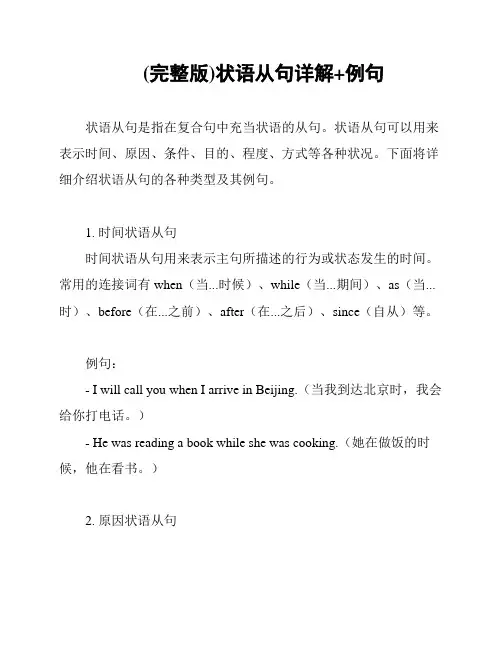
(完整版)状语从句详解+例句状语从句是指在复合句中充当状语的从句。
状语从句可以用来表示时间、原因、条件、目的、程度、方式等各种状况。
下面将详细介绍状语从句的各种类型及其例句。
1. 时间状语从句时间状语从句用来表示主句所描述的行为或状态发生的时间。
常用的连接词有when(当...时候)、while(当...期间)、as(当...时)、before(在...之前)、after(在...之后)、since(自从)等。
例句:- I will call you when I arrive in Beijing.(当我到达北京时,我会给你打电话。
)- He was reading a book while she was cooking.(她在做饭的时候,他在看书。
)2. 原因状语从句原因状语从句用来表示主句所描述的行为或状态的原因。
常用的连接词有because(因为)、since(因为)、as(由于)、for (因为)等。
例句:- I can't go to the party because I have to work.(我不能去参加派对,因为我得工作。
)- Since it is raining, we should stay at home.(由于下雨了,我们应该待在家里。
)3. 条件状语从句条件状语从句用来表示主句所描述的行为或状态的前提条件。
常用的连接词有if(如果)、unless(除非)、whether(无论)、provided(倘若)等。
例句:- If it rains tomorrow, we will stay indoors.(如果明天下雨,我们会呆在室内。
)- We can go shopping unless it is too late.(除非太晚,否则我们可以去购物。
)4. 目的状语从句目的状语从句用来表示主句所描述的行为或状态的目的。
常用的连接词有so that(以便)、in order that(为了)、lest(免得)等。
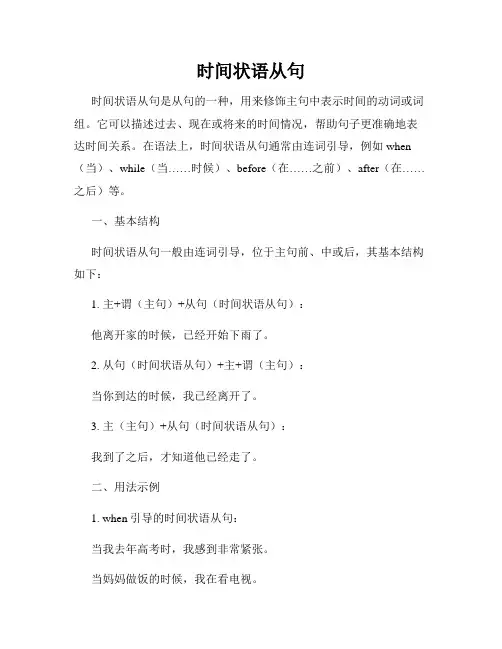
时间状语从句时间状语从句是从句的一种,用来修饰主句中表示时间的动词或词组。
它可以描述过去、现在或将来的时间情况,帮助句子更准确地表达时间关系。
在语法上,时间状语从句通常由连词引导,例如when (当)、while(当……时候)、before(在……之前)、after(在……之后)等。
一、基本结构时间状语从句一般由连词引导,位于主句前、中或后,其基本结构如下:1. 主+谓(主句)+从句(时间状语从句):他离开家的时候,已经开始下雨了。
2. 从句(时间状语从句)+主+谓(主句):当你到达的时候,我已经离开了。
3. 主(主句)+从句(时间状语从句):我到了之后,才知道他已经走了。
二、用法示例1. when引导的时间状语从句:当我去年高考时,我感到非常紧张。
当妈妈做饭的时候,我在看电视。
2. while引导的时间状语从句:他看电视的时候,我在做作业。
我喜欢唱歌,而他喜欢跳舞的时候,我们常常一起去KTV。
3. before引导的时间状语从句:在开会之前,我们需要准备好所有的文件。
我们应该在出发之前检查好所有的行李。
4. after引导的时间状语从句:他回家后,马上就洗澡了。
我想要再看一会儿电视,之后再睡觉。
三、特殊用法时间状语从句在句子中可以作为主语、宾语、状语、补语等成分的补充。
下面列举了一些特殊用法的示例:1. 时间状语从句作为主语:当你离开的时候,我会很伤心。
在阳光明媚的早晨散步,是一种享受。
2. 时间状语从句作为宾语:我告诉他,当他需要帮助时,可以找我。
现在是回家的时候了,我们应该叫出租车。
3. 时间状语从句作为状语:明天放假,当我们一起去郊游好吗?请把作业做完之后,再看电视。
4. 时间状语从句作为补语:我想知道你准备好出发之后,我们会做什么。
明天要参加考试,当测试结束之后,我们可以一起去吃饭庆祝。
综上所述,时间状语从句在句子中起到了重要的作用,可以帮助我们表达时间关系,使句子更加精确明了。
熟练掌握时间状语从句的用法,对于提高语言表达能力和写作水平都有很大的帮助。
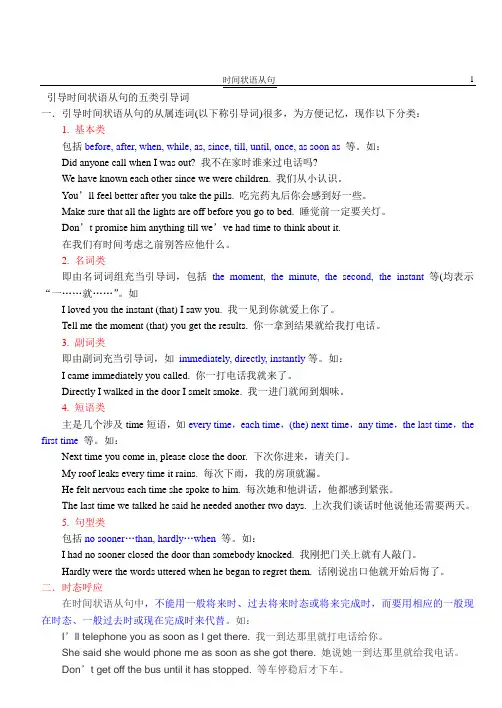
时间状语从句引导时间状语从句的五类引导词一.引导时间状语从句的从属连词(以下称引导词)很多,为方便记忆,现作以下分类:1. 基本类包括before, after, when, while, as, since, till, until, once, as soon as 等。
如:Did anyone call when I was out? 我不在家时谁来过电话吗?We have known each other since we were children. 我们从小认识。
You’ll feel better after you take the pills. 吃完药丸后你会感到好一些。
Make sure that all the lights are off before you go to bed. 睡觉前一定要关灯。
Don’t promise him anything till we’ve had time to think about it.在我们有时间考虑之前别答应他什么。
2. 名词类即由名词词组充当引导词,包括the moment, the minute, the second, the instant 等(均表示“一……就……”。
如I loved you the instant (that) I saw you. 我一见到你就爱上你了。
Tell me the moment (that) you get the results. 你一拿到结果就给我打电话。
3. 副词类即由副词充当引导词,如immediately, directly, instantly等。
如:I came immediately you called. 你一打电话我就来了。
Directly I walked in the door I smelt smoke. 我一进门就闻到烟味。
4. 短语类主是几个涉及time短语,如every time,each time,(the) next time,any time,the last time,the first time 等。
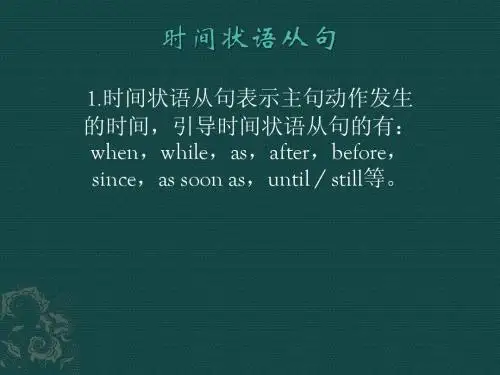
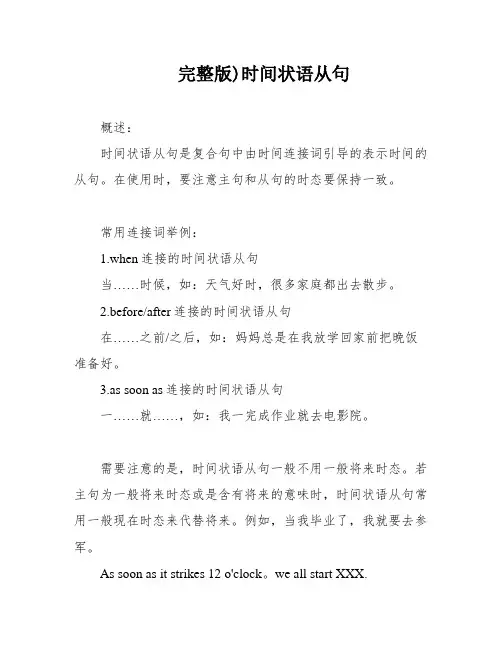
完整版)时间状语从句概述:时间状语从句是复合句中由时间连接词引导的表示时间的从句。
在使用时,要注意主句和从句的时态要保持一致。
常用连接词举例:1.when连接的时间状语从句当……时候,如:天气好时,很多家庭都出去散步。
2.before/after连接的时间状语从句在……之前/之后,如:妈妈总是在我放学回家前把晚饭准备好。
3.as soon as连接的时间状语从句一……就……,如:我一完成作业就去电影院。
需要注意的是,时间状语从句一般不用一般将来时态。
若主句为一般将来时态或是含有将来的意味时,时间状语从句常用一般现在时态来代替将来。
例如,当我毕业了,我就要去参军。
As soon as it strikes 12 o'clock。
we all start XXX.Upon our arrival。
XXX.4.时间状语从句中使用until表示一个动作一直持续到某一时刻,例如:He waited until all the people left。
我们也可以说I didn't go to bed until Mum came back。
表示直到妈妈回家后我才上床睡觉。
5.当while连接时间状语时,表示主句的行为在从句行为过程之中发生。
从句中要使用持续性动词或状态动词,并且持续性动词通常使用进行时态。
例如:While they were waitingfor the New Year。
they listened to music。
sang songs and had fun.Till and until are used to introduce time clauses in affirmative sentences。
with the main clause verb being a continuous n or state that lasts until the time XXX: XXX。
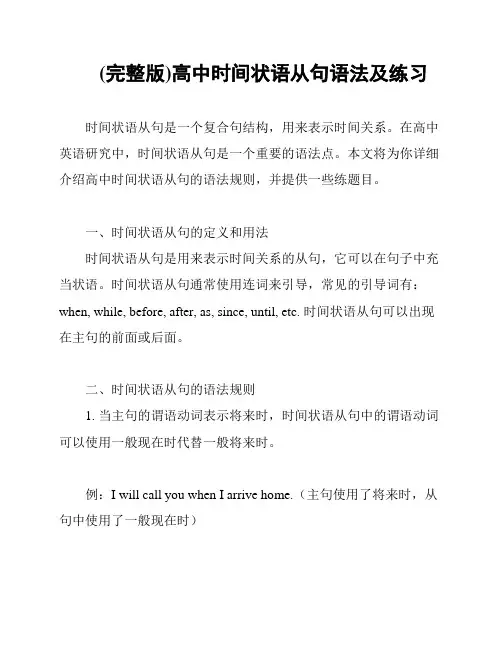
(完整版)高中时间状语从句语法及练习时间状语从句是一个复合句结构,用来表示时间关系。
在高中英语研究中,时间状语从句是一个重要的语法点。
本文将为你详细介绍高中时间状语从句的语法规则,并提供一些练题目。
一、时间状语从句的定义和用法时间状语从句是用来表示时间关系的从句,它可以在句子中充当状语。
时间状语从句通常使用连词来引导,常见的引导词有:when, while, before, after, as, since, until, etc. 时间状语从句可以出现在主句的前面或后面。
二、时间状语从句的语法规则1. 当主句的谓语动词表示将来时,时间状语从句中的谓语动词可以使用一般现在时代替一般将来时。
例:I will call you when I arrive home.(主句使用了将来时,从句中使用了一般现在时)2. 当主句的谓语动词表示过去时,时间状语从句中的谓语动词可以使用一般过去时或过去完成时代替。
例:She had finished her homework before she went to bed.(主句使用了过去时,从句中使用了过去完成时)3. 当时间状语从句表示一个惯性的动作或一个客观事实时,从句中的谓语动词可以使用一般现在时。
例:I always go for a walk when it is sunny.(从句中表示惯性的动作)三、时间状语从句的练题目1. 选择正确的连词填空:― She fell asleep _______ she finished her book.1) while 2) because 3) after― We will start the meeting _______ everyone ar rives.1) before 2) since 3) until2. 改写句子,将主句的谓语动词改为表示将来时:― I will call you when I have time.3. 改写句子,将主句的谓语动词改为表示过去时或过去完成时:― He went to bed before he finished his work.以上是关于高中时间状语从句的语法规则及练习题目的详细介绍。
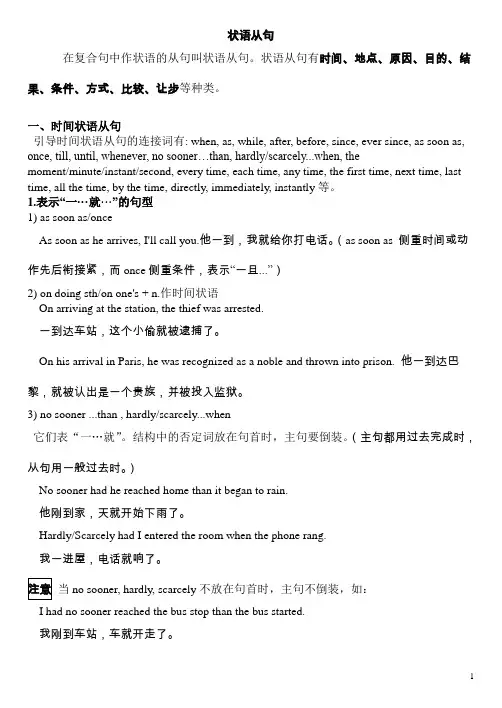
状语从句在复合句中作状语的从句叫状语从句。
状语从句有时间、地点、原因、目的、结果、条件、方式、比较、让步等种类。
一、时间状语从句引导时间状语从句的连接词有: when, as, while, after, before, since, ever since, as soon as, once, till, until, whenever, no sooner…than, hardly/scarcely...when, themoment/minute/instant/second, every time, each time, any time, the first time, next time, last time, all the time, by the time, directly, immediately, instantly等。
1.表示“一···就···”的句型1) as soon as/onceAs soon as he arrives, I'll call you.他一到,我就给你打电话。
(as soon as 侧重时间或动作先后衔接紧,而once侧重条件,表示“一旦...”)2) on doing sth/on one's + n.作时间状语On arriving at the station, the thief was arrested.一到达车站,这个小偷就被逮捕了。
On his arrival in Paris, he was recognized as a noble and thrown into prison. 他一到达巴黎,就被认出是一个贵族,并被投入监狱。
3) no sooner ...than , hardly/scarcely...when它们表“一…就”。
结构中的否定词放在句首时,主句要倒装。
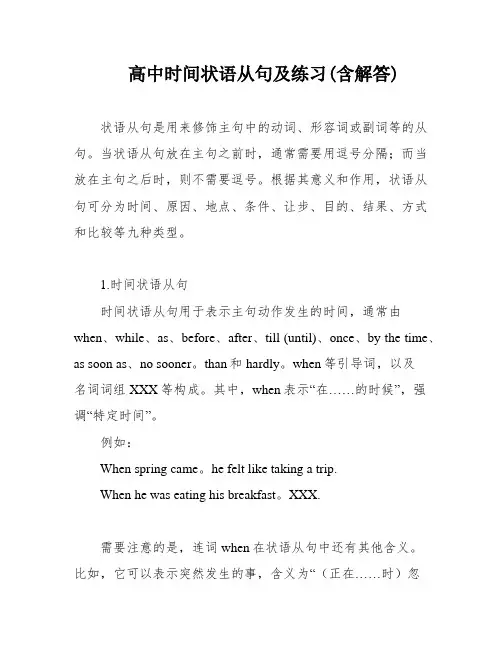
高中时间状语从句及练习(含解答)状语从句是用来修饰主句中的动词、形容词或副词等的从句。
当状语从句放在主句之前时,通常需要用逗号分隔;而当放在主句之后时,则不需要逗号。
根据其意义和作用,状语从句可分为时间、原因、地点、条件、让步、目的、结果、方式和比较等九种类型。
1.时间状语从句时间状语从句用于表示主句动作发生的时间,通常由when、while、as、before、after、till (until)、once、by the time、as soon as、no sooner。
than和hardly。
when等引导词,以及名词词组XXX等构成。
其中,when表示“在……的时候”,强调“特定时间”。
例如:When spring came。
he felt like taking a trip.When he was eating his breakfast。
XXX.需要注意的是,连词when在状语从句中还有其他含义。
比如,它可以表示突然发生的事,含义为“(正在……时)忽然”;可以表示过早发生某事,意为“(还没……)就”;还可以表示“在……的情况下”,通常译为“虽然”、“既然”、“如果”等。
举个例子:I was just coming along to see you when I ran into Wilson.I hadn’t been reading for half an hour when I heard steps outside.She refuses help when (although) she has many friends.Why do you walk when (since) you have a car?How can I make them understand if they refuse to listen to me。
It's frustrating when you XXX。
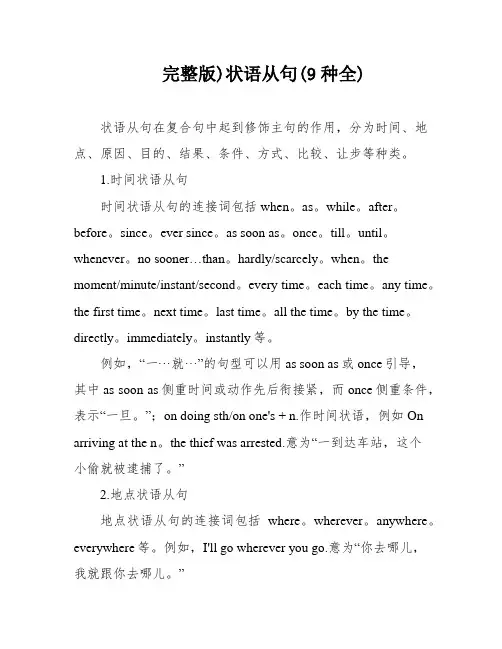
完整版)状语从句(9种全)状语从句在复合句中起到修饰主句的作用,分为时间、地点、原因、目的、结果、条件、方式、比较、让步等种类。
1.时间状语从句时间状语从句的连接词包括when。
as。
while。
after。
before。
since。
ever since。
as soon as。
once。
till。
until。
whenever。
no sooner…than。
hardly/scarcely。
when。
the moment/minute/instant/second。
every time。
each time。
any time。
the first time。
next time。
last time。
all the time。
by the time。
directly。
immediately。
instantly等。
例如,“一···就···”的句型可以用as soon as或once引导,其中as soon as侧重时间或动作先后衔接紧,而once侧重条件,表示“一旦。
”;on doing sth/on one's + n.作时间状语,例如On arriving at the n。
the thief was arrested.意为“一到达车站,这个小偷就被逮捕了。
”2.地点状语从句地点状语从句的连接词包括where。
wherever。
anywhere。
everywhere等。
例如,I'll go wherever you go.意为“你去哪儿,我就跟你去哪儿。
”3.原因状语从句原因状语从句的连接词包括because。
since。
as。
now that。
seeing that。
considering that等。
例如,Since it's raining。
we'll stay indoors.意为“因为下雨,我们将待在室内。
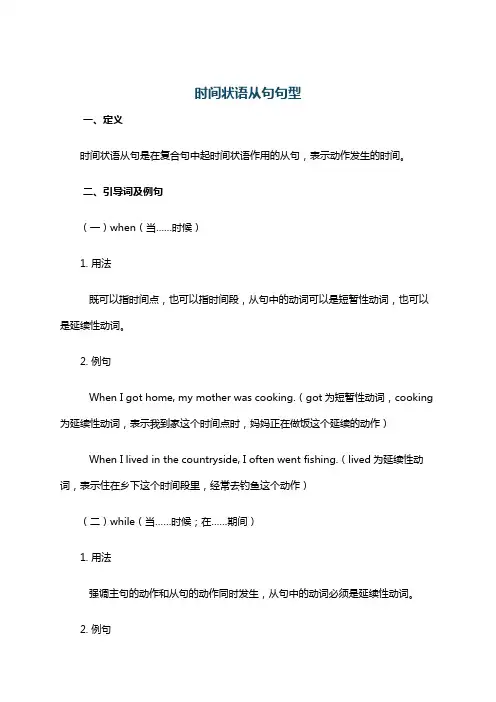
时间状语从句句型一、定义时间状语从句是在复合句中起时间状语作用的从句,表示动作发生的时间。
二、引导词及例句(一)when(当……时候)1. 用法既可以指时间点,也可以指时间段,从句中的动词可以是短暂性动词,也可以是延续性动词。
2. 例句When I got home, my mother was cooking.(got为短暂性动词,cooking 为延续性动词,表示我到家这个时间点时,妈妈正在做饭这个延续的动作) When I lived in the countryside, I often went fishing.(lived为延续性动词,表示住在乡下这个时间段里,经常去钓鱼这个动作)(二)while(当……时候;在……期间)1. 用法强调主句的动作和从句的动作同时发生,从句中的动词必须是延续性动词。
2. 例句While I was reading, my sister was watching TV.(reading和watching都是延续性动词,表示我读书和妹妹看电视这两个动作同时进行)(三)as(当……时;随着;一边……一边)1. 用法强调两个动作同时进行,可译为“一边……一边”;也可表示随着时间的推移,情况发生变化,译为“随着”。
2. 例句As we walked, we talked.(表示一边走一边交谈,walked和talked同时进行)As time goes by, we are getting older.(表示随着时间的流逝,我们正在变老)(四)before(在……之前)1. 用法表示主句动作发生在从句动作之前。
2. 例句Wash your hands before you have dinner.(洗手这个动作在吃饭之前发生)(五)after(在……之后)1. 用法表示主句动作发生在从句动作之后。
2. 例句After he finished his homework, he went to play football.(完成作业这个动作之后才去踢足球)(六)since(自从……以来)1. 用法从句用一般过去时,主句用现在完成时或现在完成进行时,表示从过去某个时间点开始一直持续到现在的动作或状态。
一、定义:在主从复合句中修饰主句中的动词、形容词、副词等的从句叫状语从句二、分类:时间状语从句地点状语从句原因状语从句目的状语从句结果状语从句条件状语从句让步状语从句比较状语从句方式状语从句三、具体(一)时间状语从句1.When(1)当……时(点动词,延续性动词)例:When he came in,he saw nobody.(点动词)When I stayed in Beijing,I got to know him.(延续性动词)(2)就在……时Be about toBe going toBe to do +whenBe doingOn the point of doing例:I was on the point of leaving,when someone came in.2.While(1)当……时(延续性动词)例:While he studied in college,he joined the Party.(2)趁着例:Cut some grass,while the son doesn't set.Strike the iron,while it is hot.(3)但是,可是,然而,表示转折例:I like pop music while he is fond of folk music.(4)虽然例:Though/while he is in poor health,he continues to work.3.As(1)当……时=when例:My cap was blown away as I stood up.(2)一边……一边(强调主句,从句同时进行)例:He was walking as he was singing.(3)随着With +n.+非谓语(分词/介词短语)As(连词)+主语+谓语例:As his hair grew grey,he felt more worried.With his hair growing grey,he felt more worried.(1)在……之前——时态1)将来(主将从现)2)过去(主句过完,从句过去)例:Before everything is ready,we will try our best.Before I came in,some students had arrived here.(2)还没……就……/……才……(主过从过)例:He almost knocked me down before he saw me.He rushed our before I could ask his name.(3)It will/won't be (long)+时间+主语+谓语动词要多久才……/不久会……例:It will be two months before we go into Grade 3.It won't be long before will meet again.另外:It was +时间+before +主语+Ved例:He said it would be 2 months before we graduated from Grade 2.5.After 在……之后(1)将来(主将从现,主将从现完)例:After you have finished homework this morning,we'll see the film.(2)一般现在(自然规律等)(3)过去(从句过完,主句一般过去)例:After he had finished his homework,he went to bed.6.Since(1)自从……(现在完成<动作从过去开始一直持续到现在,还将继续持续>,过去完成)主句现在完成时(现在完成进行时)since + 主语+V-ed例:He has taught English since he came to Hegang.He has been teaching English since he came to Hegang.(2)特殊句型It is/has been +时间(一段)+since+主语+V-ed(延续性、点动词均可)It was/had been + 时间+since +主语+had done例:It is 14 years since he smoked.It is 14 years since he died.7.until/till 直到……为止(1)……until/till(主句谓语动词是延续性动词)Not……until(主句谓语动词是点动词)例:He hadn't told me about it until I knew it.He didn't go to bed until his father came back.He studied English until his father came back.(2)not……until 放句首,主句倒装例:Not until his father came back,did he go to bed.(3)当强调until从句时,把主句not提到until前一并强调(主句还原或肯定)例:It was not until his father came back that he went to bed.(4)until表示将来,从句一般现在(现在完成)时,主句用将来时例:I won't believe you until you have carried out your promise.8.Once 一旦(条件)例:Once he is hurt,he will be far away from marrige.(主句,从句均用过去时)9.一……就……(1)the moment/second/minute(2)At the sight/sound/thought of(3)On/upon doing(4)The time (that)+主语+谓语+……+when例:Every the time he answer the phone,the teacher can catch him.By the time+主语+V-ed……,主语+had doneBy the time+主语+Vs……,主语+will have done。
状语从句一.分类:when (当……的时候) while (在……期间) as (当……的时候, 一边……一边……)before (在……之前) since (自从……以来) till/until (直到) hardly…when… (刚……就) as soon as (一……就……)after (在……之后) not…till/until(直到……才)no sooner…than…(刚……就)地点状语从句:where (在那里) wherever(无论哪里)原因状语从句:because (因为) since (因为,既然) as (由于) for (为了) now that(既然)目的状语从句:(so)that=in order that(以便)so as (not)to (以便[不])in case(以免)lest(以免)结果状语从句:so+adj./adv.+that(如此……以致)so that(结果……)such+n.+that(如果……以致)that(所以,因此)让步状语从句:though/although不可同but连用。
though/although (虽然)however (可是)even though(即使)even if (即使)no matter+what/which/where/who/when =whatever/whichever/wherever/whoever/whenever(不论什么/哪一个/哪里/谁/何时)比较状语从句:as (正如)as…as(和……一样)not as/so … as (不如……)than(比……更)the+比较级…+the+比较级(越……越……)条件状语从句:if(假设)unless(如果不)so long as(只要)on condition that (如果)方式状语从句:as(像……那样地)just as(正像)as if(好像)as though(好像)二.各种状语从句的简化方法:1例:After she sang,she left the rich man's house.= After singing,she left the rich man's house.2.以as soon as引导的状语从句的主语若与主句主语一致时,从句等于on+doing sth.,作状语,此时的动词为非延续性动词。
状语从句连词总结1 时间状语从句:when当……时候while 当……时候(动词只能是延续性动词)as当……时候(经常表示一边……一边……)after/before在……之后/之前until/till直到……(即某一持续性行为持续到某一时间点)since/ever since自从……(即子某一时间点以来,常用完成时态或完成进行时)名词性短语the time the moment the minute the day the year the first/second time each time每次every time每次next time下次any time在任何时候whenever不管什么时候by the time到……时候(即指到某一时间点为止,主句常用完成时态)一……就……as soon as once immediately directly instantly还没来得及……就……hardly……when no sooner……thanas long as长达……非时间状语从句:动词ing形式;at……形式;on doing/on sth形式2地点状语从句where在哪里,在什么地方wherever无论在哪里anywhere无论何处everywhere 到处,处处nowhere 无处,任何地方都无to/in/from the place(s)where或to/in/from any place where3原因状语从句because(语气最强)因为,多置于主句之后as(语气最弱)因为,多置于主句之前since语气较弱,常表示对方已知的事实,相当于“既然”now (that)既然for the reason that因为(that引导的是同位语从句,先行词为reason)in that由于某种原因,多用于书面语seeing that因为,鉴于4目的状语从句in order that以便so (that)为了for fear that惟恐,以防in case以防万一有某种情况发生5结果状语从句so (that)所以so……that……结构such……that……结构6条件状语从句if 如果unless 、if not除非as/so long as 、on condition that只要once一旦……就……in case假如supposing that 、given that假定providing that、provided that以……为条件,倘若7让步状语从句though、although、as 尽管even though、even if 尽管,即使wh-ever引导名词性从句可以转化为no matter+相应的wh-词8比较状语从句as……as……同级比较not as/so……as……不同级比较差级或高级比较……than……越……越……the……,the……9方式状语从句as 正如,像……as if、as though 好像详细见于《高中英语基础知识手册》。
状语从句一.分类:when (当……的时候) while (在……期间) as (当……的时候,一边……一边……)before (在……之前) since (自从……以来) till/until (直到)hardly…when… (刚……就)as soon as (一……就……) a fter (在……之后) not…till/until(直到……才)no sooner…than…(刚……就)地点状语从句: where (在那里) wherever(无论哪里)原因状语从句:because (因为) since (因为,既然) as (由于) for (为了) now that(既然)目的状语从句: (so)that=in order that(以便) so as (not) to (以便[不]) in case(以免) lest(以免)结果状语从句:so+adj./adv.+that(如此……以致) so that(结果……)such+n。
+that(如果……以致) that(所以,因此)让步状语从句:though/although不可同but连用。
though/although (虽然) however (可是) even though(即使) even if (即使)no matter+what/which/where/who/when =whatever/whichever/wherever/whoever/whenever(不论什么/哪一个/哪里/谁/何时)比较状语从句:as (正如) as…as(和……一样)not as/so … as (不如……) than(比……更)the+比较级…+the+比较级(越……越……)条件状语从句:if(假设) unless(如果不) so long as(只要) on condition that (如果)方式状语从句:as(像……那样地) just as(正像) as if(好像) as though(好像)二.各种状语从句的简化方法:1.sth.作状语。
(完整版)职场时间状语从句语法及练习一、语法介绍时间状语从句是一个从句,用于描述一个动作或事件发生的时间或条件。
它通常以连接词引导,主要分为以下几种类型:1. 当时间状语从句说明一个动作或事件与主句动作同时发生或持续发生时,请使用"when" 或 "while" 连接词。
- 例如:"When I arrived at the office, my colleague was already there."2. 当时间状语从句说明一个动作或事件发生在主句动作之前时,请使用"before" 连接词。
- 例如:"Before the meeting starts, make sure to review your presentation."3. 当时间状语从句说明一个动作或事件发生在主句动作之后时,请使用"after" 连接词。
- 例如:"After I finish this report, I will take a break."4. 当时间状语从句说明一个动作或事件发生在主句动作的一段时间之后时,请使用"after" 连接词加上一段时间状语词。
5. 当时间状语从句说明一个动作或事件发生在主句动作的一段时间之前,请使用"before" 连接词加上一段时间状语词。
- 例如:"Before you leave the office, remember to turn off the lights."二、练题请根据句子的意思,填写适当的时间状语从句。
1. _________ you finish the report, please send it to me.2. I will call you back _________ I have a break.3. _________ she arrived at the office, the meeting had already started.4. Make sure to finish the tasks _________ the end of the day.5. _________ he left the office, he locked the door.答案:1. When2. when3. When4. by5. Before。
(完整版)时间状语从句(全面掌握)状语从句思考:什么是从句?I don’t know the girl in red.I don’t know the girl who is playing under the tree.从句要素:① 至少要有两个句子② 要有引导词一、什么是状语从句状语的功用:状语说明地点、时间、原因、目的、结果、条件、方向、程度、方式和伴随状况等。
状语一般由副词、介词短语、分词和分词短语、不定式或相当于副词的词或短语来担当。
其位置一般放在句末,但也可放在句首或句中。
I didn’t realize how special my mother was until I became an adult.You should have put the book where you found it.I didn’t go because I was afraid.二、状语从句的分类1.时间状语从句2.地点状语从句3.原因状语从句4.条件状语从句5.目的状语从句6.让步状语从句7.比较状语从句8.方式状语从句9.结果状语从句10.伴随状语从句▲ 常见考点:考点一、主句与从句的时态呼应问题;考点二、连接词的选择。
考点三、状语从句与非谓语动词之间的替换;考点四、根据从句与主句的逻辑关系选用从属连词;3、时间状语从句详解1.引导词(1)基本类:before ,after ,when ,while ,as ,since ,till ,until ,once ,as soon as.(2)名词类:(由名词词组充当引导词)the moment ,the minute ,the second ,the instant ,(一…就…) every time ,each time ,the first time ,the last time(3)副词类:(由副词充当引导词)immediately ,directly ,instantly (一…就…)(4)句型类:no sooner…than… ,hardly/scarcely…when…(一…就…)2.引导词具体讲解:当…时候:It was s ix o’clock when I got home.Sb was doing sth when…1)when 这时Sb was about to do sth/was on the point of doing sth when…Sb had just done sth when…既然: It was foolish of you to take a taxi when you could walk there in five minutes.既然你能5分钟就走到那儿,再搭出租车真是太傻了。
……………………………………………………………最新资料推荐…………………………………………………引导时间状语从句的五类引导词一.引导时间状语从句的从属连词(以下称引导词)很多,为方便记忆,现作以下分类:1. 基本类包括before, after, when, while, as, since, till, until, once, as soon as 等。
如:Did anyone call when I was out? 我不在家时谁来过电话吗?We have known each other since we were children. 我们从小认识。
You’ll feel better after you take the pills. 吃完药丸后你会感到好一些。
Make sure that all the lights are off before you go to bed. 睡觉前一定要关灯。
Don’t promise him anything till we’ve had time to think about it.在我们有时间考虑之前别答应他什么。
2. 名词类即由名词词组充当引导词,包括the moment, the minute, the second, the instant 等(均表示“一……就……”。
如I loved you the instant (that) I saw you. 我一见到你就爱上你了。
Tell me the moment (that) you get the results. 你一拿到结果就给我打电话。
3. 副词类即由副词充当引导词,如immediately, directly, instantly等。
如:I came immediately you called. 你一打电话我就来了。
Directly I walked in the door I smelt smoke. 我一进门就闻到烟味。
4. 短语类主是几个涉及time短语,如every time,each time,(the) next time,any time,the last time,the first time 等。
如:Next time you come in, please close the door. 下次你进来,请关门。
My roof leaks every time it rains. 每次下雨,我的房顶就漏。
He felt nervous each time she spoke to him. 每次她和他讲话,他都感到紧张。
The last time we talked he said he needed another two days. 上次我们谈话时他说他还需要两天。
5. 句型类包括no sooner…than, hardly…when 等。
如:I had no sooner closed the door than somebody knocked. 我刚把门关上就有人敲门。
Hardly were the words uttered when he began to regret them. 话刚说出口他就开始后悔了。
二.时态呼应在时间状语从句中,不能用一般将来时、过去将来时态或将来完成时,而要用相应的一般现在时态、一般过去时或现在完成时来代替。
如:I’ll telephone you as soon as I get there. 我一到达那里就打电话给你。
She said she would phone me as soon as she got there. 她说她一到达那里就给我电话。
Don’t get off the bus until it has stopped. 等车停稳后才下车。
……………………………………………………………最新资料推荐…………………………………………………I will tell you after they leave. 于他们走后我再告诉你。
I waited till/until she was back. 我一直等到她回来Once time is gone, you will never get it back. 时间一旦失去就再也得不到了1. 时态呼应一般来讲,复合句都要遵循主、从句时态呼应规律,状语从句也不例外。
即主句用现在时,从句也用现在时;主句用过去时,从句也用过去的某种时态。
如:Be careful when you cross the road. 过马路时要小心。
You must see the doctor if you are ill. 如果你生病了,你必须去看医生。
主句是一般过去时,从句也要用一般过去时。
如:When he was seven years old, he could swim. 当他七岁时就会游泳。
She turned off the light before she left the office. 她离开办公室前就关了灯。
■与时间状语从句有关的时态问题关于这个问题有两点值得注意:(1)当主句为将来时态或具有将来意义时,时间状语从句通常要用一般现在时表示将来意义,而不能直接使用将来时态:Turn off the lights before you leave. 走前关灯。
I will tell him as soon as he arrives. 他一来我就告诉他。
(2)与since 从句搭配的主句的时态通常是现在完成时态:He has lived here since 1999. 自1999年以来,他就一直住在这儿。
Where have you been since I last saw you? 自我上次见到你之后你到哪里去了?【注】在特定的语言环境中有时也可能用过去完成时或一般现在时:It seems like years since we last met. 我们似乎几年未见面了。
Yesterday he told me that he hadn’t eaten anything since Tuesday. 他昨天告诉我自星期二以来他一直未吃任何东西。
2. 主从句的位置。
大多数情况下,从句可以位于主句之前,也可以位于主句之后。
不过从句在前时,主从句之间必须用逗号隔开。
如:Please tell me when he comes back. = When he comes back, please tell me.三.基本类(一). when, while, as的用法when只能用于一般时态,while可以用于进行时态while从句中的谓语动词必须是延续性动词;表示带有规律性的“每当”或当主、从句谓语动词的动作发生有先后时,只能用when;当表示“一边…一边…”或“随着”时,只能用as。
另外,用于此义的as 所引导的时间状语从句谓语只能是动作动词,不能是状态动词。
例题:_____ John was watching TV, his wife was cooking.A. AsB. As soon asC. WhileD. Till……………………………………………………………最新资料推荐…………………………………………………第一次描述:三者可表示“当……时候”,区别如下:(1) 若主句表示的是一个短暂性动作,从句表示的是一个持续性动作,三者都可用:He fell asleep when [while, as] he was reading. 他看书时睡着了。
【注】as 用于引出一个持续性动词表示“在……期间”时,其谓语通常只能是那些含有动作(action)和发展(development) 意味的动词,一般不能是那些不用于进行时态的动词(如be, seem, love, want, agree, see, know, have 等),所以下面一句中的while 不能换为as:A:I’m going to the post office. 我要去邮局。
B:While you’re there, can you get me some stamps?当你在邮局时,能帮我买几张邮票吗?(2) 若主、从句表示两个同时进行的持续性动作,且强调主句表示的动作延续到从句所指的整个时间,通常要用while:Don’t talk while you’re eating. 吃饭时不要说话。
I kept silent while he was writing. 在他写的时候,我默不作声。
但是,若主从句表示的两个同时进行的动作含有“一边…一边”之意思,通常用as:She sang as she went along. 她边走边唱。
(3) 若从句是一个短暂性动作,主句是一个持续性动作,可用as / when 但不用while:It was raining hard when [as] we arrived. 我们到达时正下着大雨。
(4) 若主从句表示的是两个同时(或几乎同时)发生的短暂性动作,用as / when:I thought of it just when [as] you opened your mouth. 就在你要说的时候,我也想到了。
(5) 若要表示两个正在发展变化的情况,相当于汉语的“随着”,一般用as:Things are getting better and better as time goes on. 随着时间的推移,情况越来越好。
As it grew darker, it became colder. 天色越晚,天气越冷。
(6) 表示“每当…的时候”(暗示一种规律性),一般要用when:It’s cold when it snows. 下雪时天冷。
He smiles when you praise him. 你夸奖他时他总是笑笑。
(7) 若主从句所表示的动作不是同时发生,而是有先后顺序时,一般要用when:I will go home when he comes back. 他回来时,我就回家去。
(8) when 可用作并列连词,表示“这时(突然)”;while 也可以用作并列连词,表示“而”、“却”(表示对比);但as 则没有类似用法:We were about to start when it began to rain. 我们正要出发,这时天开始下雨了。
He likes coffee, while she likes tea. 他喜欢咖啡,而她却喜欢茶。
(9) as 和when 后均可直接跟一个名词,构成省略句,但while 一般不这样用:As [When] a boy, he lived in Japan. 他小时候在日本。